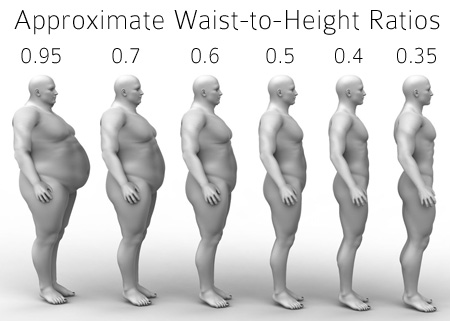Waist-to-Height Ratio as a Screening Tool for Testosterone Deficiency

A bidirectional relationship exists between excess body fat, and/or belly fat, and testosterone levels in men. That is, excess body (belly) fat decreases testosterone levels and may cause testosterone deficiency, and low testosterone levels increases body (belly) fat.[1-4] I covered this in-depth in a previous article “Testosterone and Fat Loss - the Evidence”.
In “Keep your waist to less than half your height” I introduced the waist-to-height ratio and explained that it is a better tool for predicting health outcomes and mortality than is waist circumference alone. I have also covered the association between a large waist (i.e. belly) and reduced testosterone levels in "Young Men, Waist, Testosterone and Erectile Function: Low-T is not only an old man's issue".
Here I will summarize research showing that the waist-to-height ratio can also be used as a screening tool for testosterone deficiency.
Young Men, Waist, Testosterone and Erectile Function: Low-T is not only an old man's issue

Most people, including traditional doctors, think that testosterone deficiency is an old man’s issue. This is very wrong! Actually, an excess amount of body fat can cause a man’s testosterone levels drop to as much as 10 years of aging.[1]
Several studies have demonstrated that too much body fat is associated with reduced testosterone levels independent of aging.[2-4]
Low levels of testosterone (both total and free testosterone) are a consistent feature among young men below 40 years of age with metabolic syndrome, the hallmark of which is an enlarged belly.[5]
Young men (20–39 years) with the lowest baseline total testosterone levels have the highest risk of developing cholesterol and blood fat abnormalities (dyslipidemia). [6] Compared to age-matched men with the highest baseline total testosterone levels of 663 ng/dL or higher, those with the lowest baseline total testosterone levels of 418 ng/dL or below had up to a twofold greater risk of developing an adverse lipid profile 5 years later, which in turn could contribute to future risk of cardiovascular disease.[6]
Thus, testosterone deficiency clearly has health implications also for younger men. But how much does your belly actually impact your testosterone levels… and erectile function?



